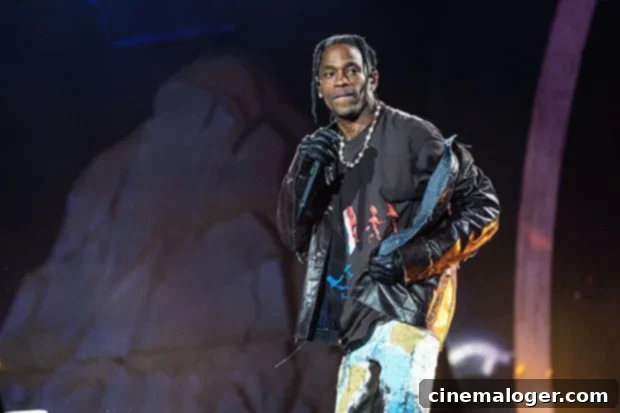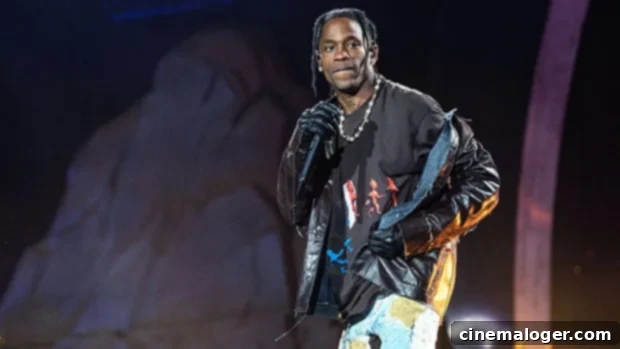Astroworld Tragedy: Compression Asphyxia Confirmed as Cause of Death for All 10 Victims Amidst Mounting Legal Challenges
In a somber and pivotal development following the tragic events at the Astroworld Music Festival, official reports have unequivocally confirmed the cause of death for all ten victims. On Thursday, December 16, a medical examiner’s office released its findings, stating that all ten individuals who lost their lives at the November 5 festival succumbed to “compression asphyxia.” This devastating conclusion sheds light on the harrowing final moments experienced by attendees at the event, which was curated by renowned rapper Travis Scott, 30. The comprehensive findings, obtained and reported by HollywoodLife, further clarified that all these tragic deaths were accidental, underscoring the unforeseen and catastrophic nature of the crowd surge incident. The confirmation of compression asphyxia as the primary cause of death has intensified public discussion and legal scrutiny surrounding the festival’s organization and crowd control measures, emphasizing the critical need for robust safety protocols at large-scale events. This official determination provides critical clarity to the ongoing investigations and the myriad of lawsuits that have followed, solidifying the narrative of a preventable disaster caused by overwhelming crowd pressure rather than individual health issues for the majority of victims. The Astroworld tragedy has, thus, become a stark example of the potential dangers inherent in inadequately managed mass gatherings.
The detailed medical examiner’s report offered crucial insights into the victims’ conditions. For nine of the ten victims, whose ages spanned a heartbreaking range from 9 to 23 years old, compression asphyxia was listed as the sole cause of death. This indicates that their inability to breathe due to immense external pressure on their bodies was the direct factor leading to their demise, with no other significant medical conditions contributing to their passing. However, the report noted an additional “contributory cause” for the oldest victim, 27-year-old Danish Baig, which included the “Combined toxic effects of cocaine, methamphetamine, and ethanol.” While these substances may have played a role in his overall physiological state, the primary cause of death remained compression asphyxia, highlighting the overwhelming and fatal force exerted by the crowd. Understanding compression asphyxia is vital in comprehending the mechanics of the Astroworld tragedy. According to the National Institute of Health’s PubMed, it is typically identified by “external pressure on the body,” usually caused by an outside force pressing down on the chest and/or abdomen. In a crowd crush scenario, this means individuals are literally squeezed, preventing their lungs from expanding and contracting, leading to suffocation. The sheer, unyielding force exerted by a densely packed and surging crowd can be immense, often likened to being crushed under a heavy weight, even without falling to the ground. This medical explanation unequivocally underscores the extreme danger posed by uncontrolled crowd dynamics at mass gatherings, emphasizing that the deaths were a direct result of physical compression rather than panic or individual health failures alone. The findings have reinforced calls for stricter crowd control and emergency response strategies.

The aftermath of the Astroworld tragedy has unleashed a torrent of legal action, with rapper Travis Scott facing an immense number of lawsuits. Following the devastating events of November 5, Scott is now confronted with over 100 lawsuits, collectively seeking an astronomical sum exceeding $3 billion in damages. These lawsuits cast a wide net, naming not only Travis Scott but also other key entities involved in the festival’s organization and execution. Among those targeted are Live Nation, the event promoter; ScoreMore, another promoter; Cactus Jack Records, Scott’s own label; and even fellow superstar rapper Drake, who made a highly anticipated special guest appearance on stage during the concert. The inclusion of Drake in some lawsuits highlights the broad legal strategy being employed by victims’ families and their legal teams, aiming to hold all parties potentially responsible accountable for the failures in crowd control and safety protocols that led to the fatalities and injuries. The sheer volume and financial scale of these legal challenges signal a determined pursuit of justice for the victims and their families, who are grappling with unimaginable grief and seeking answers regarding the preventable nature of this disaster. Each lawsuit represents a family’s attempt to reconcile with their loss and hold powerful organizations and individuals accountable for what transpired, highlighting the complex web of responsibilities in large-scale event production. The plaintiffs argue that negligence, inadequate planning, and a failure to respond swiftly to danger contributed directly to the fatal crowd crush.
A particularly poignant example of the victims’ families’ stance on accountability emerged from the family of the youngest victim, 9-year-old Ezra Blount. The Blount family steadfastly rejected Travis Scott’s offer to pay for Ezra’s funeral expenses. Their lawyer, Bob Hilliard, articulated this firm rejection in a powerful letter, obtained by Rolling Stone. Hilliard’s response underscored a deeper demand for accountability beyond monetary compensation, stating, “Your client’s offer is declined. I have no doubt Mr. Scott feels remorse. His journey ahead will be painful. He must face and hopefully see that he bears some of the responsibility for this tragedy.” This rejection by the Blount family resonated deeply with the public, symbolizing a collective desire for genuine acknowledgement of responsibility rather than merely financial gestures. It highlights the profound emotional toll and the intricate balance between sympathy and the pursuit of justice that defines the aftermath of such a catastrophe. The families are not just looking for reparations, but for a clear admission of culpability that could prevent similar tragedies in the future, signaling a shift from celebrity philanthropy to a demand for systemic change in concert safety management. Their refusal to accept the offer was a powerful statement, emphasizing that true justice involves an honest reckoning with the events that led to Ezra’s untimely death and a commitment to ensuring such a disaster never recurs, rather than a simple financial settlement.
In the immediate wake of the tragedy, Travis Scott released a statement expressing his sorrow and prayers for the victims’ families, pledging cooperation with the Houston police investigation. However, public and media scrutiny intensified as more details emerged regarding the chaotic scene and delayed response. Seeking to address the escalating concerns and clarify his perspective, the rapper sat down for his first in-depth interview with prominent media personality Charlamagne Tha God on December 9. During this highly anticipated conversation, Scott reiterated his claim that he was unaware of the severity of the situation until after his performance had concluded. “I didn’t know the exact details until [after my set], minutes before the press conference that I figured out exactly what happened,” he stated. He further asserted that had he been informed that things were “out of hand” or that there were serious safety concerns, he would have immediately stopped the concert. “Anytime you hear something like that, you want to stop the show. You want to make sure fans get the proper attention they need. Anytime I could see anything like that, I did [stop]. I stopped it a couple of times to just make sure everybody was okay. I just really go off the fans’ energy as a collective—call and response. I just didn’t hear that [this time].” This defense, however, has been met with skepticism by many, including concert-goers, safety experts, and legal representatives of the victims, who argue that as the headliner and curator, Scott held a significant responsibility for the safety and well-being of his audience, irrespective of direct communication during the performance. The debate continues to rage regarding the extent to which an artist can or should be aware of unfolding crises in a massive crowd, particularly when multiple reports suggest distress signals were visible and audible to others present. Critics point to the numerous social media videos and eyewitness accounts that depicted attendees pleading for help and the concert’s continuation for a significant period after initial reports of injury and chaos.
The Astroworld tragedy has ignited a crucial conversation about concert safety protocols, crowd management, and the responsibilities of artists and event organizers. The incident has prompted a rigorous reevaluation of emergency response plans, security staffing, and communication channels at large-scale music festivals worldwide. Experts are advocating for enhanced training for event staff to identify and respond to crowd density issues, improved egress and ingress strategies, and clearer lines of communication between stage personnel, security, and medical teams to prevent future disasters. The profound impact on the victims’ families, who continue to mourn their unimaginable losses and fight for justice, remains at the forefront of this discourse. Their unwavering pursuit of accountability seeks not only reparations but also systemic changes that will prevent such a catastrophe from ever happening again. The legal battles, potentially stretching for years, will undoubtedly set precedents for future event liability and performer responsibility, shaping the landscape of live entertainment safety for decades to come. Beyond the immediate legal and financial ramifications, the Astroworld disaster will forever be etched into the history of live music, serving as a stark reminder of the fragile line between exhilarating performance and devastating peril. It compels all stakeholders—artists, promoters, venues, and authorities—to prioritize the safety and well-being of attendees above all else, ensuring that the joy of live music never again gives way to such profound sorrow. This tragedy has become a rallying cry for improved standards, transparent safety measures, and a renewed commitment to audience welfare in the global entertainment industry. The lessons learned, though born of immense suffering, are expected to drive fundamental reforms to safeguard lives at future mass gatherings.
